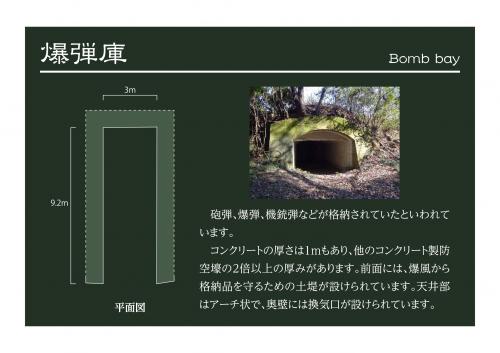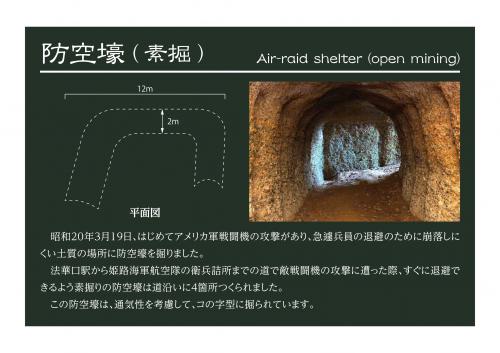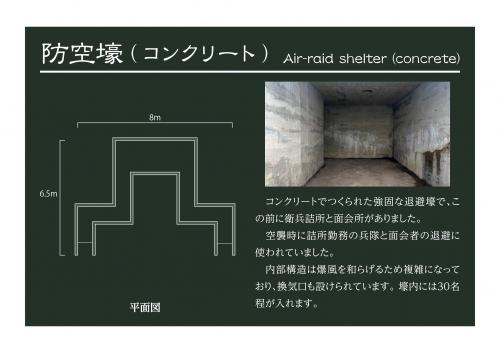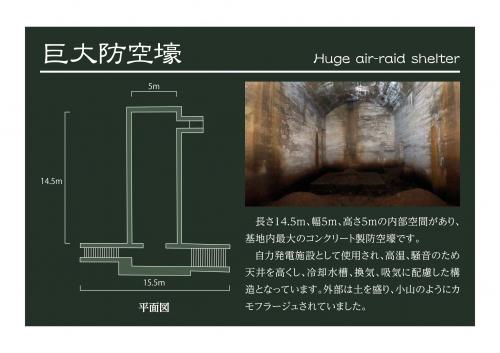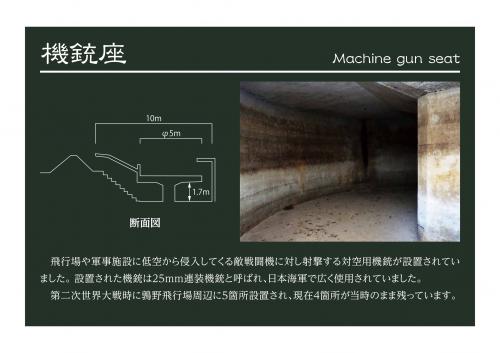本文
鶉野飛行場跡周辺の案内板(signboard list、說明牌)
案内板一覧(signboard list、說明牌)
爆弾庫
砲弾、爆弾、機銃弾などが格納されていたといわれています。
コンクリートの厚さは1mもあり、他のコンクリート製防空壕の2倍以上の厚みがあります。前面には、爆風から格納品を守るための土堤が設けられています。天井部分はアーチ状で、奥壁には換気口が設けられています。
Bomb bay
It is said that artillery shells, bombs, and machine gun shells were stored here.
The concrete is 1 meter thick, more than twice as thick as other concrete air-raid shelters. The front has an earthen embankment to protect the containment from the blast. The ceiling is arched, and ventilation openings are provided on the back wall.
彈藥庫
相傳此處曾用於存放砲彈、炸彈、機槍彈藥等。
混凝土牆厚達1公尺,比其他混凝土防空洞厚2倍以上。彈藥庫前方設有土堤以防止衝擊波引爆存放彈藥。頂部呈拱形,在洞內深處的牆面上還設有通風口。
防空壕(素掘)
昭和20年3月19日、はじめてアメリカ軍戦闘機の攻撃があり、急遽兵員の退避のために崩落しにくい土質の場所に防空壕を掘りました。
法華口駅から姫路海軍航空隊の衛兵詰所までの道で敵戦闘機の攻撃に遭った際、すぐに退避できるよう素掘りの防空壕は道沿いに4箇所つくられました。
この防空壕は、通気性を考慮して、コの字型に掘られています。
Air-raid shelter(open mining)
On March 19, 1945, American fighter planes attacked the area for the first time, and air-raid shelters were hastily dug in soil resistant to collapse in order to evacuate the soldiers.
Four air-raid shelters were dug along the road from Hokkeguchi Station to the guardhouse of the Himeji Air Group so that they could be quickly evacuated in the event of an enemy fighter plane attack.
This air-raid shelter is dug in a U-shape for ventilation.
防空洞(素掘洞)
此為1945年3月19日首次遭美軍戰鬥機襲擊時,為緊急疏散士兵,在土質不易崩塌的地方挖掘的防空洞。
為了讓人在遭敵軍戰鬥機襲擊時能夠迅速撤退躲避,在法華口站到姬路海軍航空隊衛兵崗哨站的路上,沿路挖了4個直接開鑿未另外補強的素掘防空洞。
為使空氣流通,這個防空洞被挖掘成C字型。
防空壕(コンクリート)
コンクリートでつくられた強固な退避壕で、この前に衛兵詰所と面会所がありました。
空襲時に詰所勤務の兵隊と面会者の退避に使われていました。
内部構造は爆風を和らげるため複雑になっており、換気口も設けられています。壕内には30名程が入れます。
Air-raid shelter(concrete)
It was a solid concrete shelter with a guard station and a meeting room in front of it.
It was used to evacuate soldiers on duty at the guardroom and visitors during air raids.
The internal structure is intricately designed to mitigate the blast, and ventilation openings are also provided. The bunker can accommodate about 30 people.
防空洞(混凝土)
以混凝土打造的堅固避難洞穴,前方設有衛兵崗哨站及會客室。
過去在空襲時乃用於疏散在崗哨站值勤的士兵及訪客。
為減緩衝擊波,內部結構相當複雜,並設有通風口。洞裡約能容納30人。
巨大防空壕
長さ14.5m、幅5m、高さ5mの内部空間があり、基地内最大のコンクリート製防空壕です。
自力発電施設として使用され、高温、騒音のため天井を高くし、冷却水槽、換気、吸気に配慮した構造となっています。外部は土を盛り、小山のようにカモフラージュされていました。
Huge air-raid shelter
This is the largest concrete air-raid shelter on the base, with an interior space 14.5 m long, 5 m wide, and 5 m high.
Used as a self-powered power generation facility, the ceiling was raised due to high temperatures and noise, and the structure was designed to accommodate cooling water tanks, ventilation, and air intake. The exterior was piled with earth and camouflaged as a small mountain.
巨型防空洞
內部長14.5公尺,寛和高各達5公尺,是基地內最大的混凝土防空洞。
這個可自行發電的設施,考慮到設備產生的高溫和噪音,以及通風換氣與供氣問題,將洞內頂部挑高,並設置冷卻水槽以利降溫。外部則蓋滿土壤,偽裝成小山丘的模樣。
地下防空壕(コンクリート)
コンクリートでつくられた地下構造の退避壕で深さは3m程あります。内部構造は爆風を避けるために複雑な構造になっており、換気口も設けられています。
Air-raid shelter under the ground
This is an underground shelter made of concrete and is about 3 meters deep. The internal structure is intricately designed to avoid air blasts, and ventilation openings are installed.
地下防空洞(混凝土)
以混凝土打造的地下避難洞穴,深達3公尺。為減緩衝擊波,內部結構相當複雜,並設有通風口。
機銃座
飛行場や軍事施設に低空から侵入してくる敵戦闘機に対し射撃する対空用機銃が設置されていました。設置された機銃は25mm連装機銃と呼ばれ、日本海軍で広く使用されていました。
第二次世界大戦時に鶉野飛行場周辺に5箇所設置され、現在4箇所が当時のまま残っています。
Machine gun seat
Anti-aircraft machine guns were installed at airfields and military installations to be used against enemy fighters entering from low altitudes. The machine gun installed here was called the 25mm machine gun and was widely used by the Imperial Japanese Navy.
Five were set up around Uzurano Airfield during World War 2, and four remain today in their original state.
機砲座
為了迎擊低空入侵軍機場及軍事設施的敵軍戰鬥機而設的地對空高射砲。上頭所裝載的是口徑25公厘的聯裝機槍,過去亦曾被日本海軍廣泛使用。
在第二次世界大戰時,鶉野軍機場周圍設有5處機砲座,其中4處仍維持當時的樣貌保留至今。




